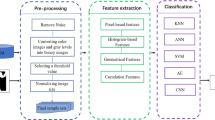Abstract
This paper compares Convolutional Neural Networks vs traditional features extraction and classification techniques for an offline recognition of handwritten digits application. The studied classification techniques are: k-NN, Mahalanobis distance and Support Vector Machines (SVM); and the hand-designed features extraction ones are: Hu Invariant Moments, Fourier Descriptors, Projections Histograms, Horizontal Cell Projections, Local Line Fitting and Zoning. The study was conducted in a practical application as is the validation of democratic elections using ballots of electoral scrutiny with non-homogeneous background. To do that it was necessary to use different preprocessing techniques (RGB conversion to gray scale, binarization and noise reduction) as well as a segmentation stage.
Access this chapter
Tax calculation will be finalised at checkout
Purchases are for personal use only
Similar content being viewed by others
References
Manoj, A., Borate, P., Jain, P., Sanas, V., Pashte, R.: A survey on offline handwriting recognition systems (2016)
Parizeau, M., Lemieux, A., Gagné, C.: Character recognition experiments using Unipen data. In: ICDAR, p. 0481. IEEE (2001)
Ghosh, R., Ghosh, M., et al.: An intelligent offline handwriting recognition system using evolutionary neural learning algorithm and rule based over segmented data points. J. Res. Pract. Inf. Technol. 37(1), 73 (2005)
Nguyen, V., Blumenstein, M.: Techniques for static handwriting trajectory recovery: a survey. In: Proceedings of the 9th IAPR International Workshop on Document Analysis Systems, pp. 463–470. ACM (2010)
LeCun, Y., Bengio, Y., et al.: Convolutional networks for images, speech, and time series. Handb. Brain Theory Neural Netw. 3361(10), 1995 (1995)
Bouchain, D.: Character recognition using convolutional neural networks. In: Institute for Neural Information Processing, vol. 2007 (2006)
Lauer, F., Suen, C.Y., Bloch, G.: A trainable feature extractor for handwritten digit recognition. Pattern Recogn. 40(6), 1816–1824 (2007)
Gonzalez, R.C., Woods, R.E., Eddins, S.L., et al.: Digital Image Processing Using MATLAB, vol. 624. Pearson-Prentice-Hall, Upper Saddle River (2004)
Hu, M.-K.: Visual pattern recognition by moment invariants. IRE Trans. Inf. Theory 8(2), 179–187 (1962)
Cuevas, E., Zaldívar, D., Pérez, M.: Procesamiento digital de imágenes con MATLAB & Simulink. Ra-Ma (2016)
Hossain, M.Z., Amin, M.A., Yan, H.: Rapid feature extraction for optical character recognition. arXiv preprint arXiv:1206.0238 (2012)
Perez, J.-C., Vidal, E., Sanchez, L.: Simple and effective feature extraction for optical character recognition. In: Selected Papers From the 5th Spanish Symposium on Pattern Recognition and Images Analysis: Advances in Pattern Recognition and Applications, Valencia, Spain (1994)
Bokser, M.: Omnidocument technologies. Proc. IEEE 80(7), 1066–1078 (1992)
Trier, O.D., Jain, A.K., Taxt, T., et al.: Feature extraction methods for character recognition-a survey. Pattern Recogn. 29(4), 641–662 (1996)
Krizhevsky, A., Sutskever, I., Hinton, G.E.: ImageNet classification with deep convolutional neural networks. In: Advances in Neural Information Processing Systems, pp. 1097–1105 (2012)
Simonyan, K., Zisserman, A.: Very deep convolutional networks for large-scale image recognition. arXiv preprint arXiv:1409.1556 (2014)
Manoj, A., Borate, P., Jain, P., Sanas, V., Pashte, R.: Offline handwriting recognition system using convolutional network (2016)
Otsu, N.: A threshold selection method from gray-level histograms. IEEE Trans. Syst. Man Cybern. 9(1), 62–66 (1979)
de Campos, T.: The Chars74K dataset: character recognition in natural images. University of Surrey, Guildford, Surrey, UK (2012)
LeCun, Y.: The MNIST database of handwritten digits (1998). http://yann.lecun.com/exdb/mnist/
Acknowledgment
This work has been partially funded by the Spanish MINECO/FEDER through the SmartElderlyCar project (TRA2015-70501-C2-1-R), the DGT through the SERMON project (SPIP2017-02305), and from the RoboCity2030-III-CM project (Robótica aplicada a la mejora de la calidad de vida de los ciudadanos, fase III; S2013/MIT-2748), funded by Programas de actividades I+D (CAM) and cofunded by EU Structural Funds.
Author information
Authors and Affiliations
Corresponding author
Editor information
Editors and Affiliations
Rights and permissions
Copyright information
© 2019 Springer Nature Switzerland AG
About this paper
Cite this paper
Enriquez, E.A., Gordillo, N., Bergasa, L.M., Romera, E., Huélamo, C.G. (2019). Convolutional Neural Network vs Traditional Methods for Offline Recognition of Handwritten Digits. In: Fuentetaja Pizán, R., García Olaya, Á., Sesmero Lorente, M., Iglesias Martínez, J., Ledezma Espino, A. (eds) Advances in Physical Agents. WAF 2018. Advances in Intelligent Systems and Computing, vol 855. Springer, Cham. https://doi.org/10.1007/978-3-319-99885-5_7
Download citation
DOI: https://doi.org/10.1007/978-3-319-99885-5_7
Published:
Publisher Name: Springer, Cham
Print ISBN: 978-3-319-99884-8
Online ISBN: 978-3-319-99885-5
eBook Packages: Intelligent Technologies and RoboticsIntelligent Technologies and Robotics (R0)




